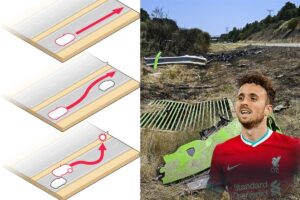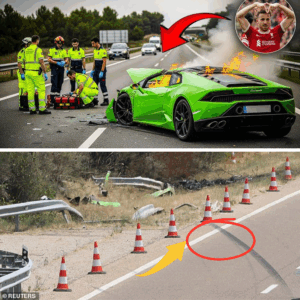Diogo Jota Crash: WhatsApp Message and Stationary Phone Signal Deepen Mystery
The tragic car crash on July 3, 2025, that claimed the lives of Liverpool FC star Diogo Jota and his brother André Silva has taken another perplexing turn. New details reveal that Jota’s wife, Rute Cardoso, received a WhatsApp message from Jota’s phone stating “All is well” just four minutes before the fatal collision on Spain’s A-52 motorway. However, a satellite ping from Jota’s phone indicates it was stationary at the time the message was sent, raising questions about the circumstances leading up to the crash. Combined with prior revelations about a stability control glitch in Jota’s Lamborghini Huracán and black box data showing gentle braking 1.2 seconds before impact, this discrepancy has sparked intense speculation among investigators, experts, and the public. This article examines the new evidence, conflicting accounts, and the broader implications for the ongoing investigation into this devastating accident.
The Crash and Its Context

Diogo Jota, 28, and his brother André Silva, 25, died when their £180,000 Lamborghini Huracán Evo Spyder veered off the A-52 motorway near Cernadilla, Spain, at approximately 12:30 a.m. The vehicle, believed to have suffered a tire blowout during an overtaking maneuver, struck the central reservation and burst into flames, leaving no chance for survival. Jota, a key player for Liverpool and Portugal, was traveling with his brother to Santander to catch a ferry to England, having been advised against flying due to a recent lung procedure. The crash occurred just 11 days after Jota married his childhood sweetheart, Rute Cardoso, leaving her and their three young children devastated.
Initial findings from the vehicle’s black box revealed that Jota, presumed to be the driver, applied gentle braking only 1.2 seconds before the collision, prompting experts to question why he didn’t brake more forcefully. Further complicating the investigation, a mechanic confirmed that the Huracán had a known stability control glitch 48 hours before the crash, which went unaddressed. Now, the WhatsApp message and the stationary phone signal introduce a new layer of intrigue, challenging assumptions about the moments leading up to the tragedy.
The WhatsApp Message and Satellite Ping Discrepancy
According to sources close to the investigation, Rute Cardoso received a WhatsApp message from Jota’s phone at approximately 12:26 a.m., stating, “All is well.” This message, sent just four minutes before the crash, suggested that Jota and Silva were safe and on track during their journey from Porto to Santander. However, a satellite ping from Jota’s phone, obtained through forensic analysis, indicates that the device was stationary at the time the message was sent. This contradiction raises critical questions: Was Jota’s phone actually stationary while the car was moving? If so, who sent the message, and under what circumstances?
Several theories have emerged to explain this discrepancy. One possibility is that Jota or Silva sent the message during a brief stop, perhaps at a rest area or roadside, before resuming their journey. The A-52 motorway, a 320-mile route connecting Porto to Santander, has several service areas where drivers can pause. If the brothers stopped to refuel, rest, or address a minor issue with the vehicle, this could account for the stationary signal. However, the tight four-minute window between the message and the crash—occurring at an estimated 190 miles into their trip—suggests that any stop was brief and that the car was moving again shortly after.
Another hypothesis is that the message was automated or sent by someone else using Jota’s phone. Modern smartphones can be configured to send pre-programmed messages, though there’s no evidence Jota had set up such a feature. Alternatively, a glitch in the phone’s GPS or satellite tracking could have misreported its status as stationary. Cybersecurity expert Dr. Maria Alvarez, consulted by El País, noted that satellite pings can occasionally be inaccurate in rural areas like Cernadilla, where network coverage is spotty. However, she emphasized that such errors are rare with high-end devices like those typically used by high-profile individuals.
Stability Control Glitch and Black Box Data

The WhatsApp mystery adds to existing questions about the Huracán’s condition and Jota’s response during the crash. A mechanic who serviced the vehicle 48 hours prior confirmed a stability control glitch, which could have impaired the car’s ability to handle a tire blowout at high speed. The electronic stability control (ESC) system, designed to prevent skids by adjusting throttle and braking, is critical for maintaining control in high-performance vehicles like the Huracán, which boasts a 640-hp V10 engine and a top speed of 200 mph. An unfixed glitch could have left Jota unable to stabilize the car after the tire failure, especially if he was traveling above the A-52’s 120 km/h (74.5 mph) speed limit, as suggested by tire marks extending 100 meters from the impact site.
The black box data, showing gentle braking 1.2 seconds before the crash, further complicates the narrative. Experts like Javier Lopez Delgado of the Spanish Association of Road Safety Auditors (ASEVI) argue that a functional ESC might have allowed Jota to slow down or steer more effectively, potentially avoiding the collision. The light braking could indicate that Jota was caught off guard by the blowout, hesitated due to the malfunctioning ESC, or prioritized steering over braking to maintain control. The stationary phone signal now raises the possibility that Jota was distracted—perhaps by sending the WhatsApp message—though this seems unlikely given the message’s timestamp and the crash’s rapid sequence.
Conflicting Witness Accounts and Road Conditions
The investigation has been fraught with conflicting accounts. Spanish police, citing tire marks and black box data, believe Jota was speeding, with the vehicle likely exceeding the 120 km/h limit significantly. However, two Portuguese lorry drivers, José Aleixo Duarte and José Azevedo, who witnessed the crash, insist the Lamborghini was traveling at a “moderate” or “super-calm” speed. Azevedo, who filmed the burning wreckage, told Correio da Manhã that the A-52’s poor road conditions—marked by uneven asphalt and potholes—likely contributed to the accident. He also faced criticism for filming rather than assisting, though he claimed he attempted to help but was unable to due to the fire’s intensity.

Javier Lopez Delgado has also criticized the A-52’s infrastructure, noting a near-fatal crash at the same location eight days prior, where a 60-year-old woman was injured after hitting the same poorly designed central reservation. Delgado suggested that the road’s faults, combined with the Huracán’s low profile and stiff suspension, could have exacerbated the tire blowout’s impact. The stationary phone signal could support the theory that the brothers stopped to inspect a road-related issue, such as a minor tire concern, before continuing, only to encounter the fatal blowout minutes later.
Investigative and Safety Implications
The WhatsApp message and stationary ping have significant implications for the investigation led by Spain’s Guardia Civil. The final report, to be submitted to the court in Puebla de Sanabria, will likely examine the phone’s forensic data to determine who sent the message and whether it indicates a stop or a technical error. If the brothers did stop, investigators will explore whether they noticed a problem with the vehicle, such as the stability control glitch or tire pressure, and why they proceeded. The possibility of driver distraction, though speculative, may also be considered, given the timing of the message.
The tragedy has reignited debates about high-performance vehicle safety and road maintenance. The Lamborghini Huracán’s recall history, including issues with crash protection brackets and safety systems, underscores the need for rigorous maintenance, especially for supercars used on public roads. The unfixed ESC glitch raises questions about accountability, with calls for stricter regulations on service delays and recall compliance. Meanwhile, the A-52’s documented hazards have prompted demands for improved road inspections, better signage, and redesigned barriers to prevent future tragedies.
The Human Toll and Football’s Response

The loss of Diogo Jota and André Silva has left an indelible mark on the football world. Tributes from teammates like Virgil van Dijk, Cristiano Ronaldo, and manager Arne Slot highlight Jota’s warmth and professionalism, describing him as a “friend to everyone” and a “loved one to all.” The brothers’ funeral in Gondomar, Portugal, drew Liverpool stars, former teammates, and fans, who laid flowers and jerseys in their honor. Rute Cardoso, now a widow with three young children—Dinis, Duarte, and Mafalda—faces an unimaginable loss, compounded by the poignant timing of the “All is well” message.
Conclusion
The revelation that Rute Cardoso received a WhatsApp message from Diogo Jota’s phone four minutes before the fatal crash, coupled with a satellite ping showing the phone was stationary, deepens the mystery surrounding this tragedy. Combined with the unaddressed stability control glitch and the black box’s evidence of gentle braking, these details suggest a complex interplay of mechanical failure, road conditions, and possible human factors. As the Guardia Civil continues its investigation, the football community mourns two young lives cut short, while advocates push for enhanced vehicle and road safety measures. The memory of Diogo Jota and André Silva, champions on and off the pitch, will endure, but their loss underscores the fragility of life and the urgent need for answers.
